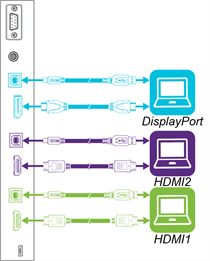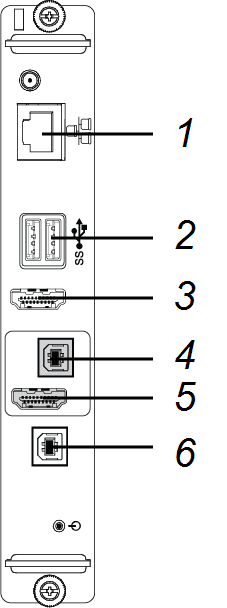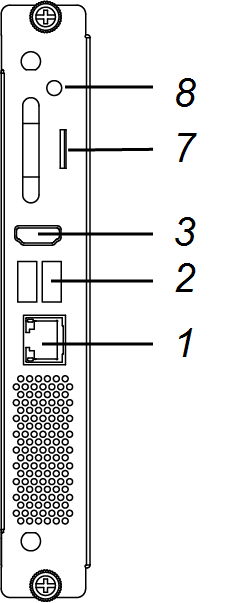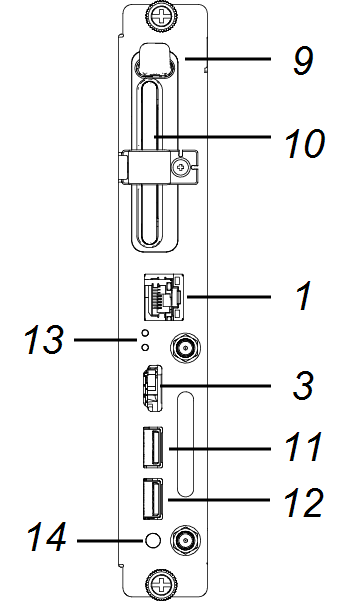Connecting power, cables and devices
Connect the display to power after you install it but before you turn it on for the first time and configure the iQ appliance. You can also connect cables for room computers, guest laptops or other input sources as well as for speakers and room control systems.
By installing cables in advance, you make use of connectors that might not be accessible after the display is wall-mounted. You can then run the cables across floors or behind walls as needed.
Warning
Ensure that any cables that cross the floor to the display are properly bundled and marked to avoid a trip hazard.

Connect the supplied power cable from the AC power inlet on the bottom of the display to a power outlet.
Note
Refer to the display’s specifications for power requirements and power consumption information (see About your display).

The iQ appliance requires a network connection for downloading software updates, and a number of the iQ appliance’s apps require a network connection as well. You can connect to a network using a Wi-Fi connection or the RJ45 jack on the iQ appliance (pictured). For more information about the iQ appliance’s network connection and configuration, see Connecting to a network.
Note
The above diagram shows the location of the RJ45 jack on the AM40 appliance. See iQ appliance reference for the location of the RJ45 jack on your specific iQ appliance model.
The SPNL‑6365‑V3/SBID-6365, SPNL‑6375‑V3, SPNL‑6365‑V2, SPNL‑6375, SPNL‑6365P and SPNL‑6375P models have an Intel Compute Card. Insert the Intel Compute Card in the slot on the iQ appliance to access its Windows 10 operating system from the display.
Note
By default, the HDMI output extends the Windows desktop, and this can cause display problems in certain configurations. If you experience issues, set the HDMI out to a mirrored desktop rather than the default extended desktop. Right click, select Display settings, and set the secondary display to mirror the first.
Tip
You can connect peripherals, such as a keyboard or mouse, to the Intel Compute Card using the USB receptacles on the iQ appliance.
You can connect cables to the display so that users can connect and use room computers, guest laptops or other devices, such as Blu-ray disc players.

The display includes up to three sets of computer connectors:
DisplayPort: This set of connectors can accommodate a USB cable for touch control and a DisplayPort cable for video and audio.
HDMI 2: This set of connectors can accommodate a USB cable for touch control and an HDMI cable for video and audio.
HDMI 1: This set of connectors can accommodate a USB cable for touch control and an HDMI cable for video and audio.
Notes
The above diagram shows the computer connectors on SPNL‑6000‑V3/SBID-6000 models. See Connector panel reference for the computer connectors available on your specific model.
SMART recommends that you use the display’s HDMI in and USB connectors (rather than those on the iQ appliance) for the best performance. You may encounter limitations if you use the connectors on the iQ appliance.
Connecting a computer to an AM30 iQ appliance requires a recent version of the appliance.
If you want to share content from a copyright-protected source (such as a Blu-ray player), connect the device to the display’s connector panel rather than to the iQ appliance.
SMART recommends the following varieties of cable:
Cable type | Maximum length | Recommendations |
|---|---|---|
23' (7 m) 1 | Use only certified HDMI cables that have been tested to support the performance standard you require. | |
23' (7 m) | Use DisplayPort 1.2 compliant or better cables. | |
16' (5 m) | Use a USB extender if the distance between the computer and the display is greater than 16' (5 m). For more information, see USB extenders. |
Using cables that exceed these maximum lengths may produce unexpected results, degraded picture quality or degraded USB connectivity.
SMART software should be installed on any computers users connect to the display. For information on installing SMART software and viewing a connected computer’s input on the display, see Connecting and using computers.
The display includes two 10 W speakers, which are designed to provide sound at the front of a room. You might want to connect the SBA-100 projection audio system (see SBA-100 projection audio system) or third-party external active speakers if you’re providing sound in a larger space.

You can connect external speakers to the display using the stereo 3.5 mm out connector (pictured). Alternatively, you can connect external speakers directly to a room computer.
Note
The above diagram shows the location of the stereo 3.5 mm connector on SPNL‑6000‑V3/SBID‑6000 models. See Connector panel reference for the location of the stereo 3.5 mm connector on your specific model.
A room control system enables users to control a room’s lighting, audio system and, possibly, the display. Some installations may require you to integrate the display with a room control system.
You can use the display’s RS-232 connector to connect a third-party external control system to the display (see Remotely managing your display).
Note
Displays are not compatible with centralized remote control systems, such as a universal remote control.
The following diagram and table present the connectors on the display’s connector panel:
SPNL‑6000‑V1 models |
All other models |
The following diagram and table present the connectors on the iQ appliance:

AM30

AM40

AM50
No. | Connector | Connects to | Notes |
|---|---|---|---|
1 | RJ45 | Network | |
2 | USB Type-A (×2) | Supported peripherals | [N/A] |
3 | HDMI out | External monitor | This receptacle is HDCP-encrypted HDMI. |
4 | USB Type-B | OPS/HDMI input (touch) | See Connecting cables for room computers, guest laptops and other input sources. |
5 | HDMI in | OPS/HDMI input (video and audio) | See Connecting cables for room computers, guest laptops and other input sources. |
6 | USB Type-B | [N/A] | This receptacle is a service port. |
7 | Micro SD | [N/A] | This receptacle is a service port. |
8 | LED | [N/A] | LED lights green when the iQ appliance is inserted in the accessory slot and turned on. |
9 | Eject button | [N/A] | This button ejects the Intel Compute Card. |
10 | Intel Compute Card | [N/A] | For iQ appliance (AM50) only. |
11 | USB Type-A | Supported peripherals | For iQ appliance (AM50) only. Supported peripherals connected to this receptacle are available in the Windows 10 operating system. See Using Input. |
12 | USB Type-A | Supported peripherals | For iQ appliance (AM50) only. Supported peripherals connected to this receptacle are available for the iQ experience. See Connecting cables for room computers, guest laptops and other input sources. |
13 | Lock and Eject LEDs | [N/A] | The Lock LED lights when the iQ appliance (AM50) shouldn’t be removed from the display. The Eject LED lights when it is safe to remove the iQ appliance (AM50) from the display. See Ejecting the Intel Compute Card. |
14 | Power button and LED | [N/A] | LED lights when the iQ appliance is inserted in the accessory slot and turned on. Press the Power button to start up Windows 10 on the Intel Compute Card. |
Not pictured | |||
13 | Intel Compute Card label | [N/A] | For iQ appliance (AM50) only The label for the Intel Compute Card. The label is titled “Assembly, PC, AM50”. |
13 | iQ appliance (AM50) label | [N/A] | For iQ appliance (AM50) only The label for the iQ appliance (AM50). The label is titled “Model / AM50”. |
Note
Older models of the iQ appliance (AM30) don’t have all the connectors.
- SMART Board 6000 and 60000 Pro installation and maintenance guide – 171167
- SPNL‑6000‑V3/SBID‑6000 installation instructions – 171193
- SPNL‑6000-V2 and SPNL‑6000P (65" models) installation instructions – 171107
- SPNL‑6000-V2 and SPNL‑6000P (75" models) installation instructions – 170996
- SPNL‑6000‑V1 installation instructions – 170641

